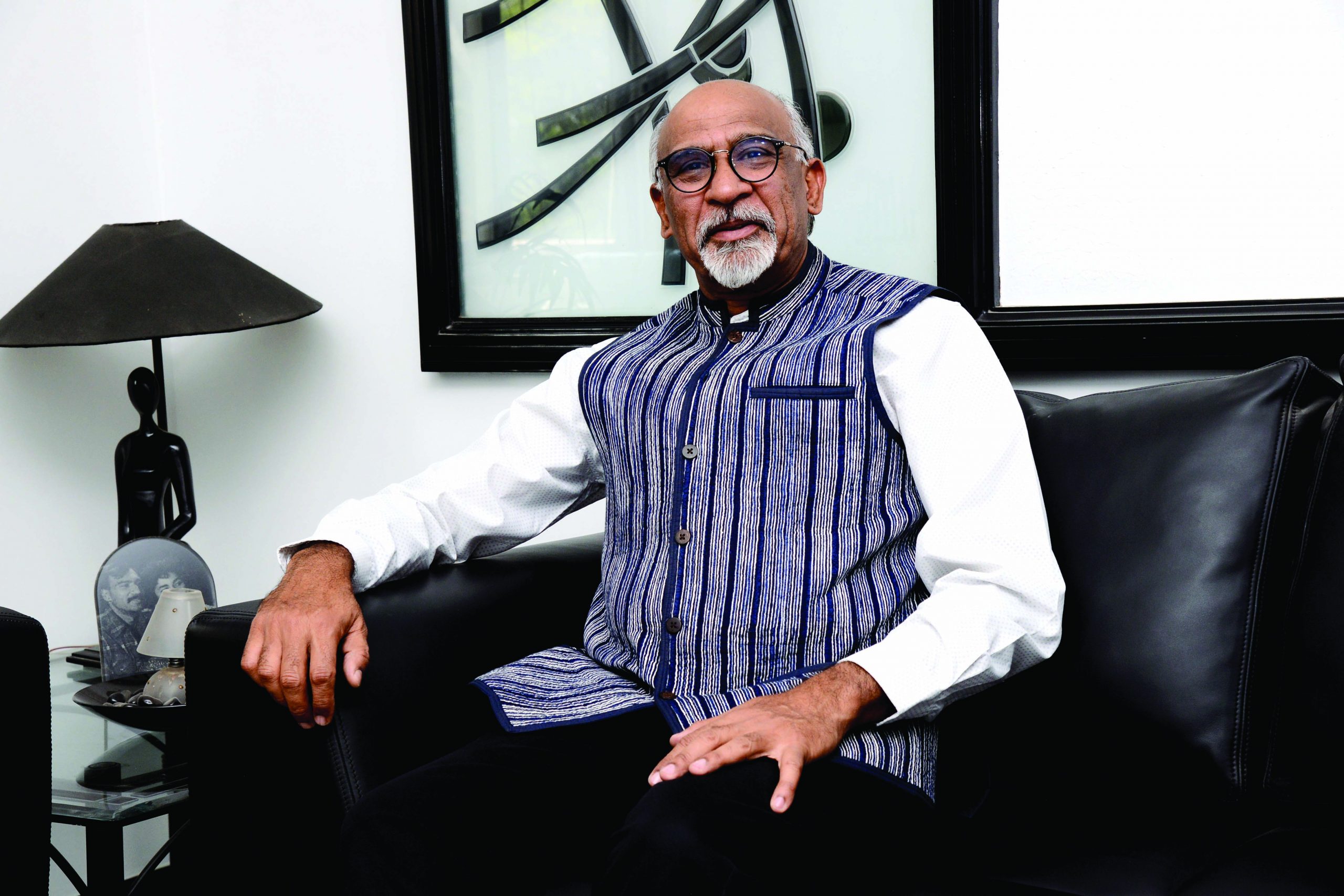“Schools need to be welcoming attractive institutions”
An architecture and industrial design alumnus of REC, Nagpur and IIT-Bombay, Dinesh Verma is founding principal partner of the Bengaluru-based Ace Group Architects (AGA, estb.1984). Over the past three decades, this firm has established a nationwide reputation for the design and construction of more than 85 pre-primary to Ph.D. education institutions across the country. Among them: Indus International School, Bengaluru; VIT University, Chennai; Reva University, Bengaluru; Dhruv World School, Pune and BDW International School, Shillong.
Excerpts from an interview with Dilip Thakore

Over the past few decades, AGA has earned a national reputation for designing and commissioning world-class campuses of some of the country’s most admired and top-ranked education institutions. Why is careful and detailed design of education institutions in the public interest?
In the late 1990s, we were invited to design the campuses of several new-genre schools including The International School Bangalore; Indus International School, Bengaluru and Hyderabad; JSS International, Ooty and DPS East, Bengaluru among others. Their distinctive campuses for the first time provided infrastructure to enable introduction of new digitally-driven pedagogies. It is in the national interest that education institutions provide children and youth holistic, well-rounded education beyond mere academics.
Some – especially Left-academics believe that capital-intensive education institutions with carefully designed buildings and landscaping are a waste of resources. What’s your comment?
First, it’s wrong to believe that good design is necessarily expensive. Carefully invested capital for future generations is never a waste. It needs to be invested to develop human resources in mind and body, to nurture students who will become contributing and highly productive leaders, managers and workers of society. Schools need to be welcoming, attractive institutions where children are eager to come every day and enjoyably learn academics, life skills and sports. In village India, the public school should be an admired institution which children love to attend and adults like to visit. During the day, they should be K-12 schools and after-school hours, they should transform into community centres providing adult education and vocational classes, reading rooms, and sports and games facilities for children and adults. When government schools transform into welcoming and resourceful community centres, entire communities will benefit.
Government schools designed and built by PWD architects tend to be unimaginative, square brick-n-mortar blocks with few differentiating characteristics. Is there a connection between the notoriously poor learning outcomes of government school children and their invariably drab architecture and landscaping?
Physical spaces undoubtedly influence what and how children learn. Everybody uses the same raw material — bricks and mortar. The differentiating factor is how creatively and effectively material is used to build schools that stimulate and enthuse the next generation to think differently. That makes all the difference. Schools and higher education institutions should provide enabling environments where learning is an immersive experience, ideas evolve and young minds think creatively and develop life and problem-solving skills. Unfortunately in our country, there’s a tendency to blindly follow rules by the book. It’s usually overlooked that rules prescribe minimum — not even comfortable — standards. In AGA, where we have a headcount of 25 architects, design and landscaping professionals, we believe that buildings and landscaping should amalgamate and reflect an aura and character that inspires learning and self-development. These design principles were applied even in our least capital intensive schools which offer free-of-charge education —Christel House, Shishu Mandir and Indus Community School — all in Bengaluru.
What are the basic campus design and landscaping rules you would advise all greenfield school promoters to follow?
Architects and landscape designers of schools need to bear in mind that they are designing child-centric environments for diverse age groups ranging from 3-18 years. Moreover, they need to remember that designing a campus is like creating a self-sustaining micro-city that requires detailed planning to include a wide range of services from transportation, meals provision to co-curricular and sports services. Enhanced institutional architecture has the power to instill a sense of awe in children and teachers alike. Education institutions need to reflect the culture, idealism and ethics of promoters, and local communities in government schools. Such schools and colleges remain etched in the minds of students. Children will carry learning and high values of their alma maters into their adult working lives to build a strong, durable and socially responsible business and government institutions. Let me share an example. We were invited to design the 12-acre Klorofeel School in Brahmapur, Odisha on the theme of ‘Beyond Green’. Therefore, the Klorofeel School campus has a rainwater harvesting pond surrounded by trees and greenery. Every student is given an 8×10 ft space around this pond to plant a tree, shrub of choice and nurture its growth. The pond also overlooks an academic space known as the Curiosity Centre, which by design is an open environment for students to visit, explore and conduct science, arts, music and literary experiments according to their inclination and choice. Feedback from the Klorofeel School, promoted by visionary edupreneurs Dr. Haribandhu Panda, Anand Rao Ladi, Kalyan Banerjee & Dr Adarsh Rath, is very encouraging. The school’s environment brings textbooks out of enclosed classrooms to open and exploratory areas where learning is an adventure for children. Provision of various child-centric spaces in which children can learn creatively has witnessed a flowering of art and expression.
Some reports indicate that as a result of the pandemic-induced shutdown of all education institutions, interference of state governments with the fees structure of private schools, and parents demanding fees concession and waivers,private edupreneurs have lost interest in promoting new, greenfield schools. To what extent, if any, has AGA suffered a decline in business?
In K-12 education, the burden of making up for the woeful shortcomings of government schools has devolved on the country’s private schools. The government doesn’t offer any rebates or subsidies to edupreneurs who promote schools. Therefore government interference with private unaided schools —some of which are world-class — is unwarranted and against the public interest. The Covid pandemic is undoubtedly a major setback for
private schools. Since they have been closed for more than a year, most of them have suffered loss of fees income while having to pay teachers and staff salaries, campus maintenance and overhead expenses. Dozens of new academic institutions, scheduled to start in 2020, have experienced loss of admissions and have cancelled expansion and promotion plans. The most well-managed top-ranked schools and colleges are making use of the time
available to renovate and upgrade their infrastructure and facilities. Despite these gloomy conditions, AGA has not suffered loss of business. During the past two years, we have signed contracts to design, build and commission 13 greenfield campuses in eight cities across the country. This is an improvement on our average of five new projects per year.
As a major employer of young, newly-qualified architects, how satisfied are you with the education and training provided by the country’s architecture schools and higher education institutions?
In India, the Council of Architecture, Delhi regulates and provides syllabus guidelines for architecture education across the country. Architecture education needs to evolve constantly. Therefore, the country’s 463 schools of architecture need to keep abreast with the latest innovations in construction and materials technology. Bridging the gap between academia and practice has been a struggle for most schools of architecture in India. As an employer of young architects, we expend considerable time, money and effort to train our recruits to become acquainted with contemporary design principles and processes in our diverse projects.
Despite India having excellent architecture and design traditions, its cities and urban spaces compare very unfavourably with their counterparts in Western countries. How do you explain this phenomenon?
The prime cause is the apathy of state governments and municipal corporations that control urban spaces in India. Unfortunately, all their time and public resources are spent in redoing and undoing, without any awareness of integrated town and civic planning. Mayors and commissioners who head municipal corporations have very limited tenure and draw up hasty and unsustainable plans. They have little understanding of town planning
and design which they tend to equate with the ‘beautification’ of chosen locations. Until our society demands integrated town planning, urban spaces will remain compromised.
Given your considerable experience in the education sector, how long will it take for India to become a well-educated, clean and green middle-class country?
There’s a strong urge in Indian society across the spectrum for high-quality education. The rising number of schools and higher education institutions even in rural India, is proof of the demand for good education. However, high-quality education is dependent upon well-qualified and experienced professionals entering the teaching profession at all levels. Once our education system attracts the best minds, India’s future will become bright because we have the world’s largest child and youth population which is eager to learn and succeed.

















Add comment